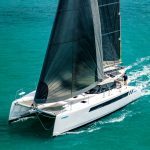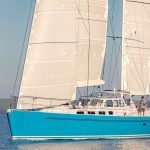‘Behemoth’ is a word which springs to mind or, perhaps more nautically, ‘leviathan’.
- Port hull dedicated to an owner’s suite
- Extensive sail plan
- With its lithium ion batteries, there’s no need for a noisy generator
- Easy to handle, rewarding to steer and trim

























